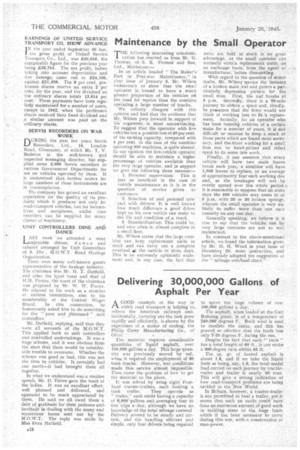Maintenance by the Small Operator
Page 20

If you've noticed an error in this article please click here to report it so we can fix it.
THE fol:owing interestino. communication has reached us from Mr. G. Thomas, ofS. E. Thomas and Son, Ltd., Maidstone:— Jim an article headed " The Maker's Part in Post-War Maintenance," in your issue of January 5, Mr. Wilson endeavours to show that the small operator is bound to have a mucir greater proportion of his vehicles oft the road for repairs than the combine operating a large number of trucks.
We entirely disagree with this opinion and find that the evidence that Mr. Wilson puts forward in support ol his argument is most unconvincing. To suggest that the operator with five vehicles has a passible loss of 40 per cent. of his earning capacity, compared with 4 per cent. in the case of the cornbimi operating 500 machines, is quite absurd. In our opinion the five-vehicle operator should be able to maintain a higher percentage of vehicles available than the very large operator, and in support we give the following three reasons:—
1. Personal supervision: This is just as beneficial in the case of vehicle maintenance as it is in the question of service given to C ustomers, • 2. Selection of and personal contact with drivers: It is well known how much difference a good driver kept on his own vehicle can make to the life and condition of.a truck.
3 Standardization: This could be, and very often is, almost complete in a small fleet.
Mr. Wilson states that the large corncan keep replacement units in stock and can Carry out a complete overhaul et the outside in three days. This is an extremely optimistic statement and, in any case, the fact that units are held in stock is no great advantage, as the small operator can normally 'obtain replacement units, on an exchange basis; from the agent or manufacturer, before dismantling.
With •regard to the question of minor faults, Mr. Wilson quotes the instance of a broken main leaf and paints a particularly, depressing picture for the small man. First, the leaf breaks at 5 p.m. Secondly, there is a 20-mile journey to obtain a spare and, thirdly, he presumes that the fitter would not think of working late to fit .a replacement. Actually, for an operator who has been running vehicles of a certain make for a number of years, it is not difficult or ruinous to keep a stock of those parts which are found most necessary, and the fitter working for a small firm can be hand-picked and relied upon to do some late work.
Finally, if one assumes that every vehicle' will have two main leaves break each year. a combine will have 1,000 leaves to replace, or an average of approximately four each working day and, as the breakages will not be evenly spread over the whole period,s it is reasonable to suppose that on some days the 500 vehicles may come in at 5 p.m. with 20 or 30 broken springs, whereas the small operator is very unlikely to suffer more than one such casualty on any one day.
Generally speaking, we believe it is true to say that the vehicles ran by very large concerns are not so well maintained.
In contrast to the above-mentioned article, we found the information given by Mr. D, H. Wood in your issue of Decembei 20, most instructive, and have already adopted the suggestion of the " mileage overhaul chart."




















































